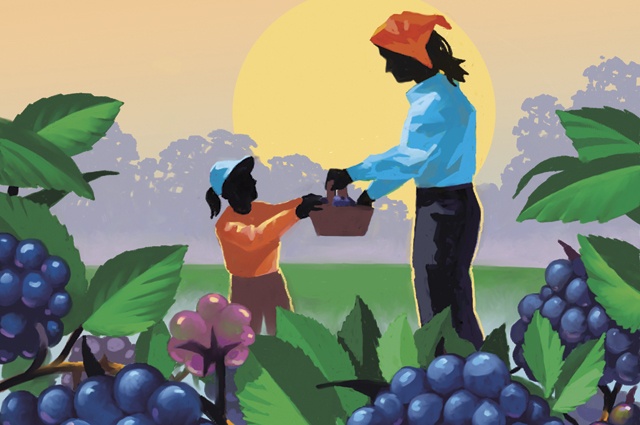Mention blackberries these days, and most people think about the sassy smart phones so beloved in the business world. Apps, e-mails, spreadsheets.
The blackberries I’m talking about grow particularly well throughout Central and East Texas. Some say too well. These tough weeds grow along fences, ditches and railroad tracks, forming dense, thorny thickets ready to snag livestock—and be plundered by happy berry hunters.
Picking berries—blackberries and their cousins, shrubby dewberries—starts summer off on a tasty note. Ask anyone who grew up going on berry-picking expeditions, and reminiscences as sweet as the berries will be shared.
Chiggers and stickers may come to mind first. But then, stories of a beloved grandmother or aunt making jams and cobblers for the family are savored, evoking a slower life long past. You, too, can still make your own memories, along with the cobbler. It’s a taste of summer you’ll never forget.
The Differences
Though subtle, there are differences between dewberry and blackberry plants. The Southern dewberry (Rubus trivalis, the variety that grows well throughout Central and East Texas) is a sprawling shrub with woody, tangled stems that trail along the ground. The blackberry (Rubus fruticosus) is larger and sends up long, arching canes on thorny brambles.
But then some blackberries do trail. After all, as members of the rose family, the berries are related. Even botanists can get stuck trying to classify some species. As they say, it’s a thorny issue. Blackberries and dewberries have prickles, spread prodigiously, produce delicious fruit and provide a great excuse to get out of the house and go foraging in late spring and early summer. Do some fieldwork. Sample, sample, sample.
You’ll be in good company: In his book “Flora and Fauna of the Civil War: An Environmental Reference Guide,” author Kelby Ouchley describes the fervor over berries, including this passage from Union Gen. William T. Sherman’s memoirs: “I have known the entire skirmish line, without orders, to fight a respectable battle for the possession of some old fields full of blackberries.”
A medical treatise from a Civil War surgeon lists blackberries as a powerful astringent used to treat dysentery, diarrhea, kidney stones and snakebite. According to other sources, blackberry leaves have also made a fine, dark hair dye throughout the centuries.
Modern-day medical research shows that blackberries and dewberries are jam-packed with antioxidants that can help prevent cancer and heart disease. Tasty, low-calorie (before the cobbler, anyway!) and super nutritious. What’s not to like? OK. Let’s go berry picking.
Hunt Your Own
One strategy is to scavenge the sunlit ditches and railroad tracks along rural roads. The idea is to tread softly while carrying a big stick to whack the brambles and chase off any snakes that might be snoozing in the shade. Long sleeves protect against thorns. Pants and boots protect against chiggers and mosquitoes. Wearing shorts and sandals is suicidal in chigger-infested territory. To avoid a chigger chow-down starring yourself as dinner, dust a mixture of sulphur and talcum powder on your legs and arms. It’s stinky, but effective.
Stuff your pockets with plastic grocery bags for the harvest. But be careful: You’ll crush the delicate berries on the bottom if you overpack bags.
Pick Your Own
If you don’t have access to wild blackberries and dewberries, a pick-your-own farm provides the thrill of the hunt with virtually guaranteed success. Many Internet sites, such as www.pickyourown.org, list Texas blackberry and dewberry farms.
Children love the excitement of picking their own berries. Adults love it, too, and enjoy getting high-quality, fresh fruit from a known source. Many farms grow berries organically or use minimal pesticides.
Grow Your Own
For some of us highly urban, properly tamed folk, there’s always the backyard. Stumbling out the back door in your bathrobe to hunt down breakfast is one of life’s simple pleasures. A handful of plump, juicy berries still touched by dew, sprinkled with brown sugar and topped with a dollop of yogurt starts any day off well.
Blackberries are super easy to grow. The cultivated wild Southern blackberry comes in many excellent varieties, even thornless. Years ago, no thorns pretty much meant no berries, but I’m asking my local agriculture Extension agent about a thornless variety that will do well in my area.
Head out to the country and enjoy a berry delicious start to a Texas summer.
——————–
Suzi Sands, art director


